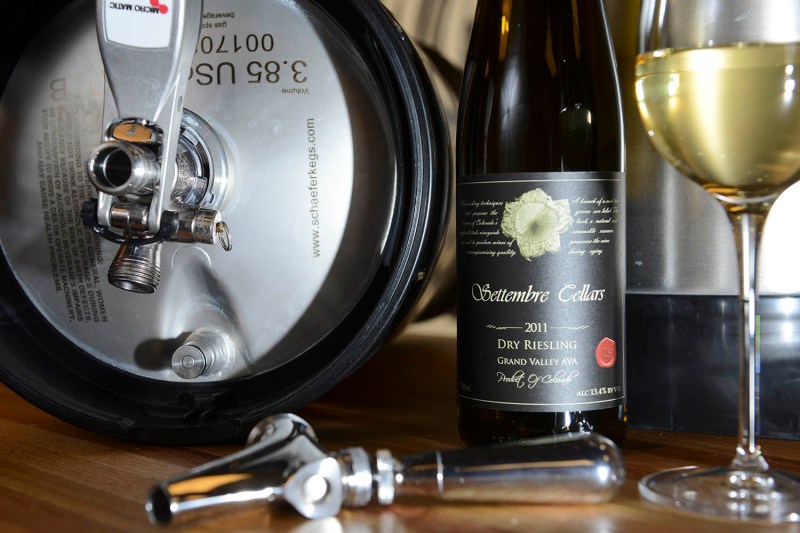Keg wine has become more common than ever and the reasons to support the stuff are many. It’s a functional, environmentally friendly option that’s being taken more and more seriously by wine pros and drinkers alike. Turns out, tap lines are not just for fresh-hop IPAs and pilsners; they’re for Sauvignon Blanc and Cabernet Franc too.
First, a bit of history. Wine on draft is nothing new, first gaining a hold in certain markets a couple of decades back. The problem, however, was perception, as is typically the case with wine. Most people thought there was no way a good wine could be served from a draft handle. And, regrettably, many people continue to feel that way today.

Jordan Sager is the co-president of Winesellers, Ltd in the Midwest. The Illinois importer first began to sell keg wine in 2013, an organic Gruner Veltliner from Austria. “The trend is strong now, and as more diners see wine drafts in restaurants and on wine lists, the more comfortable they will be with it,” Sager says of keg wine. “Similar to beer, at one time, draft was resigned to lower quality brands, but the craft beer revolution has proved that quality beverages perform very well on draft.”
The draft lines themselves are super convenient, all the better for pouring efficiently and at temperature. “When it comes to wine, a well-built draft system will pour a perfect glass of wine at the perfect temperature,” Sager said. “The systems are dual-zone temperature controlled so whites come out at 45-50 degrees and reds come out at 55-60 degrees, much cooler than that wine by the glass sitting at room temperature on the bar top. In addition, there is zero oxidation in a draft system because the gas protects the wine from oxygen entering the keg and line.”
This is often superior to the old way, which involved corking a half-open bottle one day and pouring from it the next. With more and more glass pour lists in the mix and busy restaurants looking for ease of use, you can see why it would be popular. And that’s to say nothing of the sustainability implications.
Glass is not great stuff. It requires a lot in the way of resources to make, is heavy and therefore expensive to ship, and, while recyclable, is often thrown into landfills. Kegs can be used over and over again and offer so much more in terms of liquid-to-vessel ratio. It can be argued that really high-end wines built for aging need a glass bottle to evolve over time. Fine, as most of what’s going to the keg is wine for immediate consumption. And again, because of the environment and being on a gas line, once that keg is tapped, the wine inside is going to fare much better than a bottle (to the tune of months, not just days). We don’t need to put a fine Bordeaux to keg, but many, many other wines are great candidates.
Bruce Schneider is a managing partner at Gotham Project in New York. The company kegs the lion’s share of its work (80 percent with the rest going into aluminum cans). “All wines meant to be consumed within 2-3 years of production, which are the vast majority, thrive with wine on tap,” he says. “Another way to think about it is any wine that works well under screw top is also a good candidate for wine on tap.”
Keg wine hasn’t taken over the market but more and more options are coming online. Some bars, like Coopers Hall in Portland, have gone all in with wine on tap. Mindful drinkers are encouraged to check out their local wine bars and restaurants to see what’s available. Email your importers and see what they might have as well as where it’s distributed. It’s not something most would set up at home, but draft wine systems continue to be in high demand, at newer restaurants especially.
Producers are increasingly dipping their toes in draft wine too. Many start slow, doing a few kegs here and there for select distributors or restaurant or bar accounts. Eventually, once a system is in place and the infrastructure is there, it can become a significant means of their wine program. What’s cooler, larger venues like music festivals and pro sporting events—places that have traditionally lacked quality wine in abundance—can take on kegs of fine wine.
Wineries like Mesina Hof in Texas are trying it out, attracted to being genuinely green and also saving some dough. They contend that they save real money on bottle costs. Keep in mind that most wine kegs store some 120 glasses of wine. That’s more than two cases of wine and nearly 27 individual bottles they don’t have to buy, fill, and hope people recycle.
Have you tried it yet? Keg wine is the way of the future, it’s worth checking in on. And it’s only going to become more prevalent and accessible.
Editors' Recommendations
- How to open a wine bottle without a corkscrew
- What is low-acid coffee (and should you make the switch)?
- The classic vodka cocktails you need to know how to make
- The best Belgian beers you can find everywhere
- Healthy grilling ideas: These foods will have you feeling great all summer long


